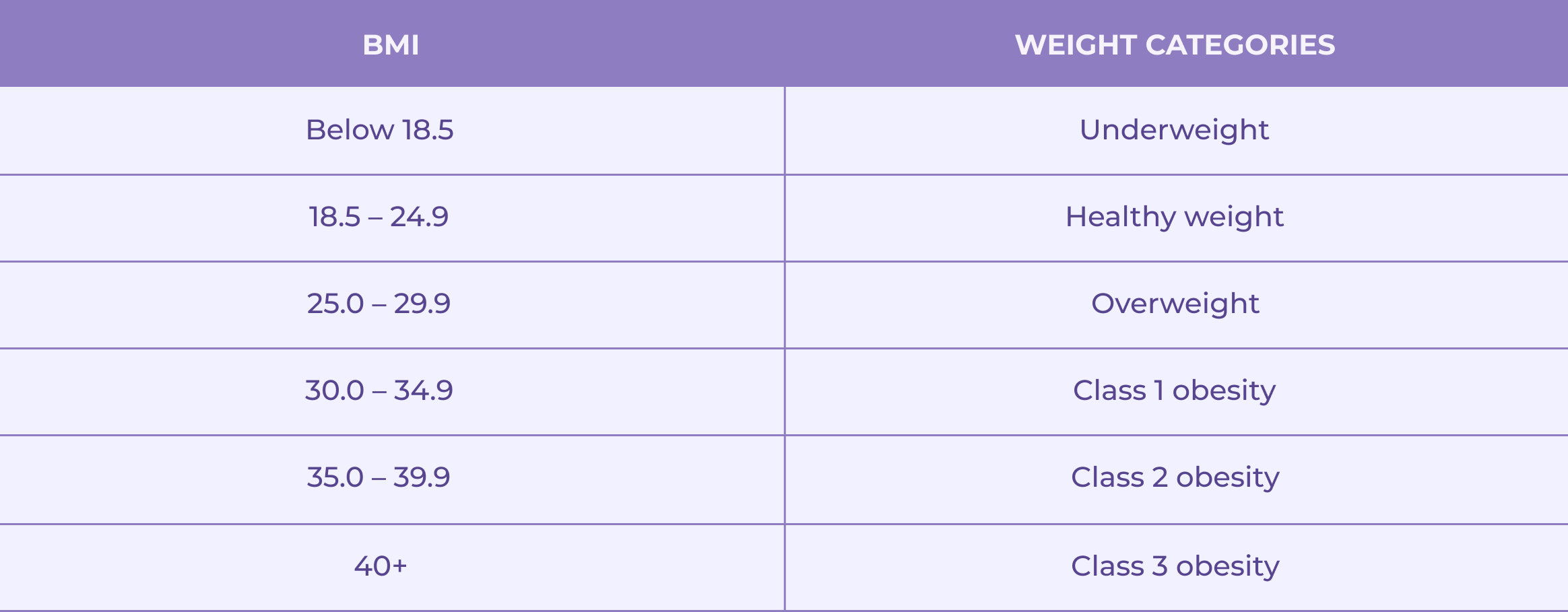Simple’s BMI Calculator: how to calculate — and understand — your body mass index

Your BMI, or body mass index, gives you a quick insight into one aspect of your health: how heavy you are compared to how tall you are. It’s used as a rough way to assess body fat levels. While it’s a simple, fast method that has some “back of the napkin calculation” value, it also has some key flaws.

Once you’ve used our BMI (body mass index) calculator to learn your BMI, you need to know how to interpret it so you can determine whether BMI is a useful data point in your quest for better health.
Let’s learn more about:
- how to calculate your BMI;
- what it does and – doesn’t tell – you about your health; and
- how to improve it … should you wish to!
Simple’s BMI calculator
Add your weight and height into our Simple BMI calculator. It’ll crunch your numbers and give you your BMI. Check your number against the chart below and see where you land!
Note that our BMI calculator is designed for adults who are not pregnant or lactating.
How does Simple’s BMI calculator work?
Our BMI calculator works by applying this calculation:
weight (lb) / [height (in)]^2 x 703
or
weight (kg) / [height (m)]^2
Now, unless you’re a math whiz or just have an uncanny ability to remember 10th-grade math class, you’ve probably forgotten (just like we have) what it means to square a number. That’s why BMI calculators are so useful. They do the math for you.
You might notice that our BMI calculator doesn’t ask for your age or sex / gender. That’s because BMI categories apply equally across male and female (sex) / men and women (gender). That’s one of the limitations we’ll come back to later on.
Now that you’ve tried calculating your BMI, let’s talk about what it is.
What is body mass index (BMI)?
Your BMI is a measure of your weight compared to your height. It’s broadly used to determine whether you’re underweight, “healthy weight,” overweight, or obese — and whether you’re at risk for any health conditions associated with those body weights.[1]
Can BMI measure body fat?
In general, across an entire population (think: 100 million people), BMI can broadly estimate who might have more or less body fat.[2] So, in that big group, people with very high BMIs are likely to have more body fat, while people with very low BMIs are likely to have less.
But, BMI is not an accurate measure of body fat for individuals because weight is made up of things like bone and muscle mass as well as fat mass.[3] (What weight is made of is known as body composition.)
Additionally, where your fat is distributed — for instance, whether it’s around your internal organs versus, say, on your butt — is also important in calculating health outcomes and disease risks.[4] We’ll look at that in a moment.
Using this simple calculation based on your weight and height leaves out these details, which makes it misleading for some people.

Let’s look at an example.
John and George have the same BMI of 27. This classifies them both as overweight.
John is 56 years old, has a sedentary lifestyle, and struggles with emotional eating. If we were to zoom in on his body composition, we’d see that he has high body fat. So, for John, BMI is a useful piece of data that tells him more about his health status and potential risks.
George is a 24-year-old personal trainer who lifts weights, plays football, and never misses his vegetables and protein. Zooming in on his body composition, we can see he has lots of lean muscle mass, dense bones, and low body fat. For him, BMI does not reflect his health status or disease risk accurately.
So, to know whether BMI is a useful reference point for your health, you’ll also want to know more about your body composition and, of course, your other lifestyle habits. Don’t worry: there are ways you can assess this without X-ray glasses (or calipers or bioelectrical impedance machines)! We’ll get to that shortly.
Why is knowing your BMI important?
If your BMI accurately reflects your relationship to body fat, that’s helpful to know. Because body fat affects metabolic and hormonal health,[5] having relatively higher body fat levels increases your risk of various health conditions, like type 2 diabetes, heart disease, and cancer. (And, having very low body fat can also increase your risk of some health conditions, like low bone density or osteoporosis.[1])
High BMI can also predict issues like joint degeneration (e.g., knee arthritis) or a risk of falling because the load on our bones and connective tissues goes up with higher weight, even if we’re leaner, active, and healthy.[6]
Knowing your body weight and fat levels means you can decide what to do to best support your health and well-being. If you’re concerned about your BMI, chat with your doctor. That’s always a good place to start.
If you’re eager to start taking action on improving your health, take our Simple quiz. We’re here to help you try intermittent fasting, rock your nutrition, and move toward your goals with small, doable actions that add up to meaningful changes in your life and body. Remember, fasting may not be for everyone, so if you have any health conditions or are on medications, consult with your healthcare provider before making any significant changes.
BMI chart for adults
As you’ll see in the BMI chart below, we calculate and interpret BMI the same for men and women. For people aged 20 and older, BMI has four weight categories that apply equally regardless of sex or age.

Limitations
For most adults, BMI is a decent estimate of your weight-related health risks.
That said, there are some people who fall into the 25–35 BMI range for whom BMI may not give an accurate reflection of health status or risk.[7] Those people include those who are:
- Pregnant or lactating: BMI categories don’t apply when you’re pregnant or lactating, as baby-related weight isn’t part of the BMI equation.
- Very muscular: BMI assumes you have an average amount of body fat. If you’re heavier than average due to your muscle mass, your BMI will be higher than your body fat would warrant.
- Of East or South Asian origin: People of Asian origin can have a lower BMI despite a higher level of visceral fat (fat deep inside your abdomen). This means their health risk increases at a lower BMI, particularly as intra-abdominal fat carries a greater risk for developing health conditions than subcutaneous fat (fat just under the skin). The World Health Organisation recommends that some Asian groups should be considered overweight if their BMI is over 23 and obese with a BMI of over 25.[8]
- Older people (over 65, possibly over 60). Older people tend to have less muscle mass and more body fat than younger people, mainly because of natural lifestyle changes as we age.[9] Here, the BMI weight categories adjust slightly, with the 25–29 range being seen as ideal and beneficial for health for those over 65.[10]
As we’ve seen, the main limitation of BMI for adults is that it doesn’t directly measure body fat. It’s a “best guess” based on average healthy weight ranges for people of each height.
Plus, BMI doesn’t consider where fat is on our bodies. As we saw above, those who carry more visceral fat (i.e., in their abdominal cavity, around their internal organs) have a higher risk of developing health conditions than those who have mostly subcutaneous fat (i.e., fat under the skin — the stuff you can pinch).[11] That means someone who’s apple-shaped could have the same BMI as someone who’s pear-shaped, yet their health risk may not be the same.
BMI also doesn’t factor in age, sex, ethnicity / ancestry (which includes genetic factors), fitness level, or any lifestyle behaviors like nutrition, exercise, and sleep. Yet all of these can have a bearing on our body-fat-to-muscle ratio.
Bear all of this in mind as you explore your BMI and what it means for you. Remember that BMI is not a diagnostic tool — it’s just one data point in the broader context of your overall health.
Tips on how to lower your BMI safely

If your BMI is higher than you would like, try these tips to bring it down safely.
Try intermittent fasting
Lose weight without counting calories or giving up all your favorite foods? Yes, it is possible!
Intermittent fasting is a way to structure your daily eating so that you have a sustained period of time each day where you don’t eat. This naturally cuts your calories down and allows your body to go into a metabolic state called ketosis, where you burn stored fat for energy rather than the calories you’re eating. Both these things help you to lose weight.
Is fasting good for you? Yes! There are a ton of health benefits with intermittent fasting.
Is intermittent fasting safe? Also yes, but for some people, caution is needed. To make sure you’re safe, you need the go-ahead from your doctor to try fasting if you:
- have a body mass index (BMI) < 18.5
- have (or are at risk of having) an eating disorder or have a history of one
- are under the age of 18, or 80 years old or more
- have a medical condition
- take prescription medications
- are extremely active
- are pregnant, breastfeeding, or trying to conceive
Try this to get started
We have a comprehensive set of resources to help you get going on your fasting journey.
- Start here: intermittent fasting for beginners.
- Get through your first two weeks with ease and grace by sidestepping these intermittent fasting side effects and avoiding these rookie intermittent fasting mistakes.
- If you get stuck, this guide is your go-to: what to do when intermittent fasting is not working.
- If you’re feeling doubtful, take a look at the evidence here: does intermittent fasting work?
Eat a balanced diet
Making more balanced food choices helps your body find a healthy, happy weight over time.
Aim to consume more:
lean proteins (like chicken, fish, turkey, eggs, and tofu), calcium-rich foods (like dairy, calcium-fortified dairy-free products, and tofu), fruits, vegetables, and whole grains (like quinoa and buckwheat).
Aim to consume less:
high fat and high sugar foods, ultra-processed foods, and alcohol.
Try this to get started
Write down what you ate today. Then ask yourself: how could you make one meal a little healthier? Could you:
- swap fried chicken for baked?
- reduce your pasta portion?
- switch a cookie for an apple?
- add some extra veggies?
To make this easier, try our Simple app. You can log your meals quickly and easily, and our Nutrition Scores system will analyze how those meals help you move toward more vibrant health and sustained weight loss. Hop on our Simple quiz to set up your free account and get started!

Get active
Being consistently active supports having a healthy BMI.[12]
Aim to do more:
walking, dancing, strength training, swimming, frisbee-tossing, yard work — any activity you enjoy.
Aim to do less:
sitting still (fidgeting is a valid movement option!).
Try this to get started
Think of the most enjoyable physical activity you can imagine (or at least, the one you’ll dislike the least — for some, exercise is tough to “enjoy,” and that’s OK) that’s practical and possible for you. Maybe it’s walking around the block or doing a 5-minute online yoga video. Start there.
If that feels outta reach, think movement rather than exercise. What gets you off the couch and moving? How could you do more of that and/or make that thing more active? If you love:
- cooking — could you cook more? (Think of all that grocery shopping, chopping, and stirring!)
- reading — could you walk with an audiobook playing in your ears (please be safe on the roads).
- sewing — could you make your sewing machine a standing one or tackle a big project that requires wrestling with long swathes of fabric (from experience, we know how physical that can get!)?
Eat mindfully

One of the best ways to eat the ideal amount for your body’s needs is to practice mindful eating.
Aim to do more:
eating slowly and focusing on the tastes, textures, aromas, etc., of your food.
Aim to do less:
eating while distracted or engaged in an absorbing activity like watching TV, scrolling social media, or driving a car.
Try this to get started
At your next meal, set a timer for one minute. For that minute, focus all your attention on the food you’re eating. This is like a meditation practice, so know that it’s OK to find it challenging! Over time, build up the length of time you can eat with a mindful presence and notice the impact it has on your appetite, fullness, and cravings.
When to consult a doctor about your BMI
If you’re worried about your BMI or you don’t know where to start to make healthful changes, check in with your doctor. Team up on this one and tackle it together. It always helps to have support and guidance.
Not quite! 1 lb. of muscle weighs the same as 1 lb. of fat. However, 1 lb. of muscle is denser — in other words, it takes up less space in your body than 1 lb. of fat. That means that if you lose fat and gain muscle, you may not lose weight, but you will lose size.
For measuring your body fat and correlated health risk, there may be better methods than BMI.
For a low-tech option, try calculating your waist circumference, waist-to-hip ratio, or body circumference measurements.
For high-tech peeps, try bioelectrical impedance analysis (BIA), skinfold calipers, or a Bod Pod.
If you have diabetes, we’d recommend getting the go-ahead from your doctor before you try intermittent fasting. For a more in-depth take, check out our guide to intermittent fasting for diabetes.

- Bhaskaran K, Dos-Santos-Silva I, Leon DA, Douglas IJ, Smeeth L. Association of BMI with overall and cause-specific mortality: a population-based cohort study of 3·6 million adults in the UK. Lancet Diabetes Endocrinol. 2018 Dec;6(12):944–53.
- Sun X, Yan N, Peng W, Nguyen TT, Ma L, Wang Y. Association between body mass index and body fat measured by dual-energy X-ray absorptiometry (DXA) in China: a systematic review and meta-analysis. Global Health Journal. 2023 Jun 1;7(2):61–9.
- Lee DH, Keum N, Hu FB, Orav EJ, Rimm EB, Willett WC, et al. Predicted lean body mass, fat mass, and all cause and cause specific mortality in men: prospective US cohort study. BMJ. 2018 Jul 3;362:k2575.
- Ross R, Neeland IJ, Yamashita S, Shai I, Seidell J, Magni P, et al. Waist circumference as a vital sign in clinical practice: a Consensus Statement from the IAS and ICCR Working Group on Visceral Obesity. Nat Rev Endocrinol. 2020 Mar;16(3):177–89.
- Oh YH, Choi S, Lee G, Son JS, Kim KH, Park SM. Changes in Body Composition Are Associated with Metabolic Changes and the Risk of Metabolic Syndrome. J Clin Med Res [Internet]. 2021 Feb 13;10(4).
- Nedunchezhiyan U, Varughese I, Sun AR, Wu X, Crawford R, Prasadam I. Obesity, Inflammation, and Immune System in Osteoarthritis. Front Immunol. 2022 Jul 4;13:907750.
- CDC. Body mass index (BMI) [Internet]. Centers for Disease Control and Prevention. 2022 Jun 3.
- Asia-Pacific Steering Committee. The Asia-Pacific Perspective: Redefining Obesity and Its Treatment. Health Communications Australia; 2000. 56 p.
- Chang SH, Beason TS, Hunleth JM, Colditz GA. A systematic review of body fat distribution and mortality in older people. Maturitas. 2012 Jul;72(3):175–91.
- Kıskaç M, Soysal P, Smith L, Capar E, Zorlu M. What is the Optimal Body Mass Index Range for Older Adults? Ann Geriatr Med Res. 2022 Mar;26(1):49–57.
- Saad RK, Ghezzawi M, Horanieh R, Khamis AM, Saunders KH, Batsis JA, et al. Abdominal Visceral Adipose Tissue and All-Cause Mortality: A Systematic Review. Front Endocrinol . 2022 Aug 22;13:922931.
- Godoy-Cumillaf A, Fuentes-Merino P, Díaz-González A, Jiménez-Díaz J, Martínez-Vizcaíno V, Álvarez-Bueno C, et al. The Effects of Physical Activity and Diet Interventions on Body Mass Index in Latin American Children and Adolescents: A Systematic Review and Meta-Analysis. Nutrients [Internet]. 2020 May 12;12(5).
